Short-Term Ocean Rise Effects on Shallow Groundwater in Coastal Areas: A Case Study in Juelsminde, Denmark
Abstract
:1. Introduction
2. Materials and Methods
2.1. Study Area and Geological Setting
2.2. Data
2.3. Data Preparation
Manual Analysis of the Sea Level and Groundwater Interaction
2.4. Response Time from the Sea Level Rise
2.5. Attenuation of Groundwater Peak
2.6. Predictive Model
- Groundwater level from the past four days;
- Sea level from the past four days and one day into the future (using the DMI’s one-day forecast);
- Precipitation from the past 24 h and one day into the future (using the DMI’s one-day forecast);
- Sine and cosine curve representing seasonality.
3. Results and Discussion
3.1. Groundwater Wave Characteristics
3.2. Sensitivity and Dependency Analysis
3.3. Predictability of Groundwater Fluctuations
4. Conclusions
Author Contributions
Funding
Data Availability Statement
Acknowledgments
Conflicts of Interest
References
- IPPC. Sea Level Rise and Implications for Low-Lying Islands, Coasts and Communities. In Special Report on the Ocean and Cryosphere in a Changing Climate, 1st ed.; Contribution of Working Group II to Technical Support, Unit; Pörtner, H.O., Roberts, D.C., Masson-Delmotte, V., Zhai, P., Tignor, M., Poloczanska, E., Mintenbeck, K., Alegría, A., Nicolai, M., Okem, A., et al., Eds.; Cambridge University Press: Cambridge, UK, 2019; pp. 321–447. [Google Scholar]
- NOAA. Global and Regional Sea Level Rise Scenarios for the United States: Updated Mean Projections and Extreme Water Level Probabilities Along U.S. Coastlines. In 2022 Sea Level Rise Technical Report, 1st ed.; Sweet, W.V., Hamlington, B.D., Kopp, R.E., Weaver, C.P., Barnard, P.L., Bekaert, D., Brooks, W., Craghan, M., Dusek, G., Frederikse, T., et al., Eds.; National Oceanic and Atmospheric Administration, National Ocean Service: Silver Spring, MD, USA, 2022; p. 111. [Google Scholar]
- Davtalab, R.; Mirchi, A.; Harris, R.J.; Troilo, M.X.; Madani, K. Sea Level Rise Effect on Groundwater Rise and Stormwater Retention Pond Reliability. Water 2020, 12, 1129. [Google Scholar] [CrossRef] [Green Version]
- Sangsefidi, Y.; Bagheri, K.; Davani, H.; Merrifield, M. Data Analysis and Integrated Modeling of Compound Flooding Impacts on Coastal Drainage Infrastructure under a Changing Climate. J. Hydrol. 2023, 616, 128823. [Google Scholar] [CrossRef]
- Robinson, C.E.; Xin, P.; Santos, I.R.; Charette, M.A.; Li, L.; Barry, D.A. Groundwater Dynamics in Subterranean Estuaries of Coastal Unconfined Aquifers: Controls on Submarine Groundwater Discharge and Chemical Inputs to the Ocean. Adv. Water Resour. 2018, 115, 315–331. [Google Scholar] [CrossRef]
- Bowes, B.D.; Sadler, J.M.; Morsy, M.M.; Behl, M.; Goodall, J.L. Forecasting Groundwater Table in a Flood Prone Coastal City with Long Short-Term Memory and Recurrent Neural Networks. Water 2019, 11, 1098. [Google Scholar] [CrossRef] [Green Version]
- Knott, J.F.; Elshaer, M.; Daniel, J.S.; Jacobs, J.M.; Kirshen, P. Assessing the Effects of Rising Groundwater from Sea Level Rise on the Service Life of Pavements in Coastal Road Infrastructure. Transp. Res. Rec. J. Transp. Res. Board 2017, 2639, 1–10. [Google Scholar] [CrossRef] [Green Version]
- Habel, S.; Fletcher, C.H.; Rotzoll, K.; El-Kadi, A.I.; Oki, D.S. Comparison of a Simple Hydrostatic and a Data-Intensive 3D Numerical Modeling Method of Simulating Sea-Level Rise Induced Groundwater Inundation for Honolulu, Hawai’i, USA. Environ. Res. Commun. 2019, 1, 041005. [Google Scholar] [CrossRef]
- Bosserelle, A.L.; Morgan, L.K.; Hughes, M.W. Groundwater Rise and Associated Flooding in Coastal Settlements Due to Sea-Level Rise: A Review of Processes and Methods. Earths Future 2022, 10, e2021EF002580. [Google Scholar] [CrossRef]
- Habel, S.; Fletcher, C.H.; Rotzoll, K.; El-Kadi, A.I. Development of a Model to Simulate Groundwater Inundation Induced by Sea-Level Rise and High Tides in Honolulu, Hawaii. Water Res. 2017, 114, 122–134. [Google Scholar] [CrossRef]
- Hoover, D.J.; Odigie, K.O.; Swarzenski, P.W.; Barnard, P. Sea-Level Rise and Coastal Groundwater Inundation and Shoaling at Select Sites in California, USA. J. Hydrol. Reg. Stud. 2017, 11, 234–249. [Google Scholar] [CrossRef] [Green Version]
- Bjerklie, D.M.; Mullaney, J.R.; Stone, J.R.; Skinner, B.J.; Ramlow, M.A. Preliminary Investigation of the Effects of Sea-Level Rise on Groundwater Levels in New Haven, Connecticut, 1st ed.; U.S. Geological Survey: Reston, VA, USA, 2012; pp. 1–46. [Google Scholar]
- Trglavcnik, V.; Morrow, D.; Weber, K.P.; Li, L.; Robinson, C.E. Analysis of Tide and Offshore Storm-Induced Water Table Fluctuations for Structural Characterization of a Coastal Island Aquifer. Water Resour. Res. 2018, 54, 2749–2767. [Google Scholar] [CrossRef] [Green Version]
- Habel, S.; Fletcher, C.H.; Anderson, T.R.; Thompson, P.R. Sea-Level Rise Induced Multi-Mechanism Flooding and Contribution to Urban Infrastructure Failure. Sci. Rep. 2020, 10, 3796. [Google Scholar] [CrossRef] [PubMed] [Green Version]
- Knott, J.F.; Jacobs, J.M.; Daniel, J.S.; Kirshen, P. Modeling Groundwater Rise Caused by Sea-Level Rise in Coastal New Hampshire. J. Coast. Res. 2019, 35, 143–157. [Google Scholar] [CrossRef]
- Cooper, H.M.; Zhang, C.; Selch, D. Incorporating Uncertainty of Groundwater Modeling in Sea-Level Rise Assessment: A Case Study in South Florida. Clim. Chang. 2015, 129, 281–294. [Google Scholar] [CrossRef]
- Kystdirektoratet. Revurdering og Ajourføring af Risikoområder for Oversvømmelse fra Hav og Vandløb. Oversvømmelsesdirektivet, Anden Planperiode, 1st ed.; Kystdirektoratet: Lemvig, Denmark, 2018; p. 38. [Google Scholar]
- Houmark-Nielsen, M. Pleistocene stratigraphy and glacial history of the central part of Denmark. Bull. Geol. Soc. Denmark 1987, 36, 1–189. [Google Scholar] [CrossRef]
- Houmark-Nielsen, M. The Pleistocene of Denmark: A review of stratigraphy and glaciation history. Dev. Quat. Sci. 2004, 2, 35–46. [Google Scholar] [CrossRef]
- Stattegger, K.; Leszczyńska, K. Rapid sea-level rise during the first phase of the Littorina transgression in the western Baltic Sea. Oceanologia 2023, 65, 202–210. [Google Scholar] [CrossRef]
- Vejledning om Højdesystemet. Available online: https://www.retsinformation.dk/eli/mt/2005/2 (accessed on 19 June 2023).
- Géron, A. Support Vector Machines. In Hands-On Machine Learning with Scikit-Learn, Keras & TenserFlow—Concepts, Tools, and Techniques to Build Intellegent Systems, 2nd ed.; Butterfield, N., Taché, N., Cronni, M., Kelly, B., Cofer, K., Eds.; O’Reilly Media, Inc.: Sebastopol, CA, USA, 2019. [Google Scholar]
- Dodge, Y. The Consise Encyclopedia of Statistics, 1st ed.; Springer: New York, NY, USA, 2008; pp. 1–583. [Google Scholar]
- Everitt, B.S.; Skrondal, A. The Cambridge Dictionary of Statistics, 4th ed.; Cambridge University Press: Cambridge, UK, 2010. [Google Scholar]
- Slooten, L.; Carrera, J.; Castro, E.; Fernàndez-Garcia, D. A Sensitivity Analysis of Tide-Induced Head Fluctuations in Coastal Aquifers. J. Hydrol. 2010, 393, 370–380. [Google Scholar] [CrossRef]
- Sánchez-Úbeda, J.P.; Calvache, M.L.; López-Chicano, M.; Duque, C. The effect of non-tidal components, the use of peak delays, and depth of measurement for the application of tidal response methods. Water Resour. Manag. 2018, 32, 481–495. [Google Scholar] [CrossRef]
- Erskine, A. The effect of tidal fluctuation on a coastal aquifer in the UK. Ground Water 1991, 29, 556–562. [Google Scholar] [CrossRef]
- Levanon, E.; Shalev, E.; Yechieli, Y.; Gvirtzman, H. Fluctuations of fresh-saline water interface and of water table induced by sea tides in unconfined aquifers. Adv. Water Resour. 2016, 96, 34–42. [Google Scholar] [CrossRef]
- Schwarts, F.W.; Zhang, H. Response of an Unconfined Aquifer to Pumping. In Fundamentals of Groundwater; Flahive, R., Powell, D., Eds.; John Wiley and Sons: New York, NY, USA, 2003; pp. 258–273. [Google Scholar]
- Duque, C.; Meyer, R.; Sonnenborg, T.O. Saltwater intrusion in Denmark. Boletín Geológico Min. 2022, 133, 29–46. [Google Scholar] [CrossRef]
- Michael, H.A.; Russoniello, C.J.; Byron, L.A. Global assessment of vulnerability to sea-level rise in topography-limited and recharge-limited coastal groundwater systems. Water Resour. Res. 2013, 49, 2228–2240. [Google Scholar] [CrossRef]
- Climate Change Knowledge Portal—Denmark. Available online: https://climateknowledgeportal.worldbank.org/country/denmark/climate-data-historical (accessed on 16 June 2023).
- Tabeller—Måned—DMI. Available online: https://www.dmi.dk/vejrarkiv/manedens-sasonens-og-arets-vejr/tabeller-maned/ (accessed on 16 June 2023).
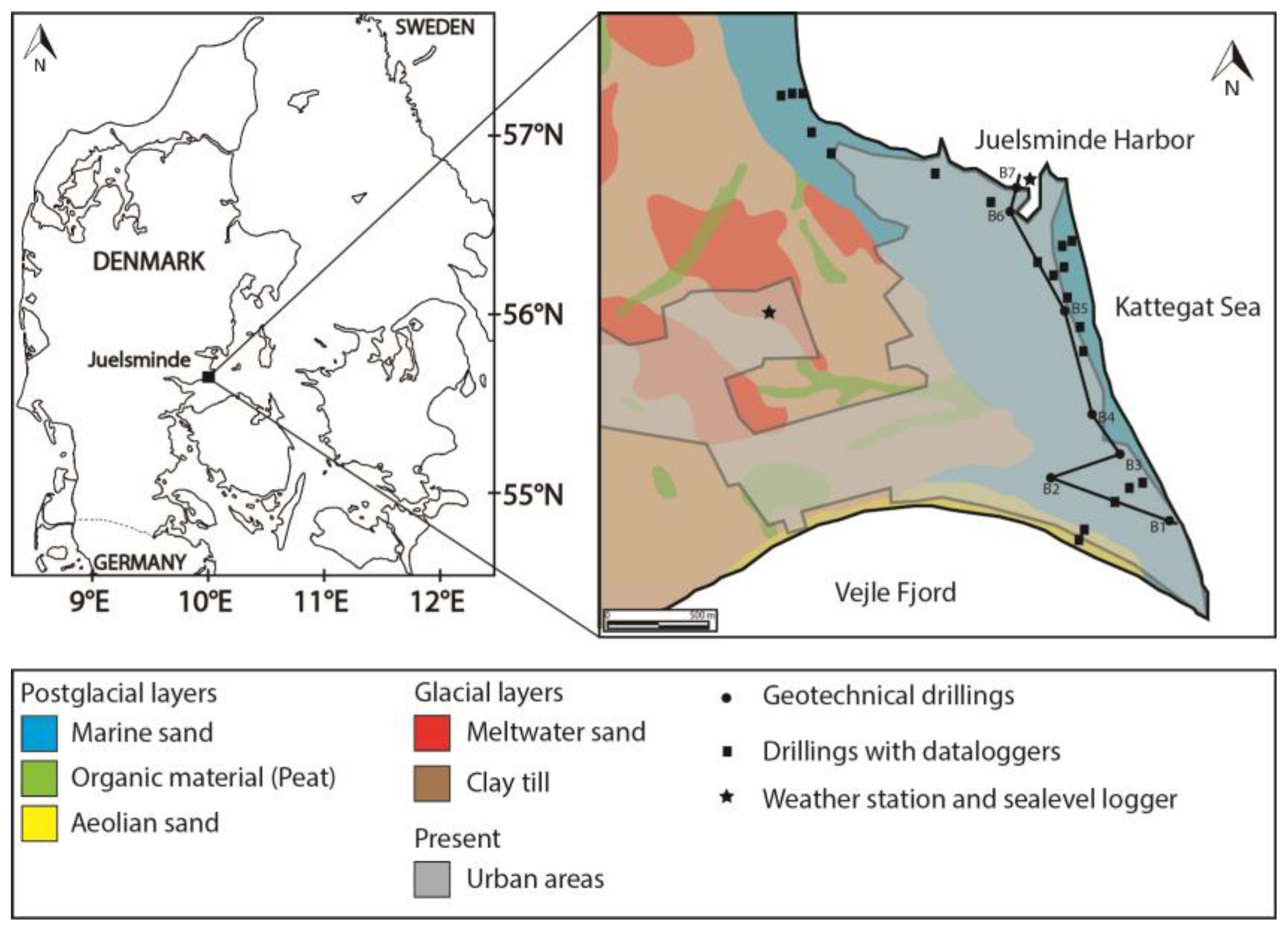

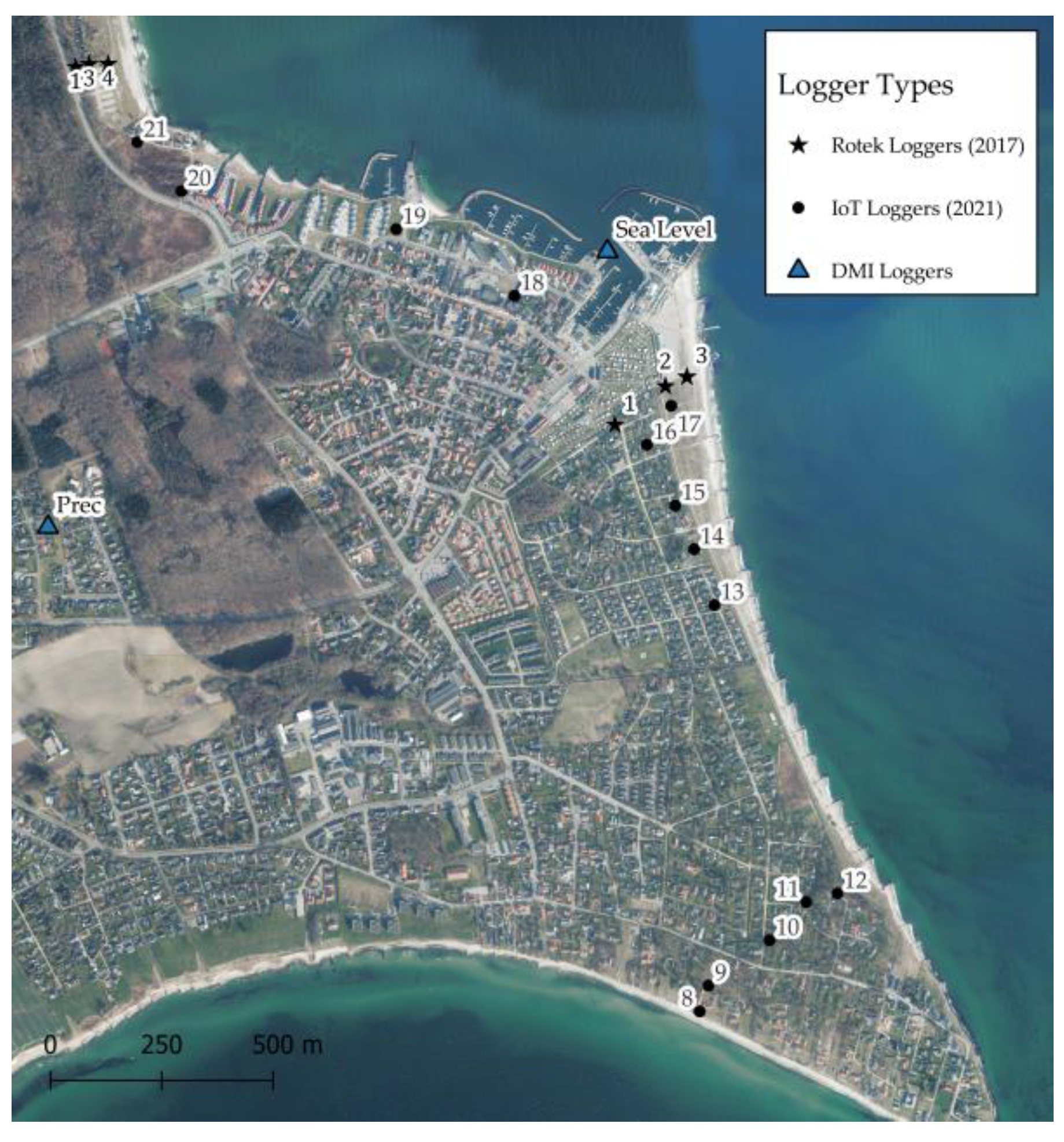
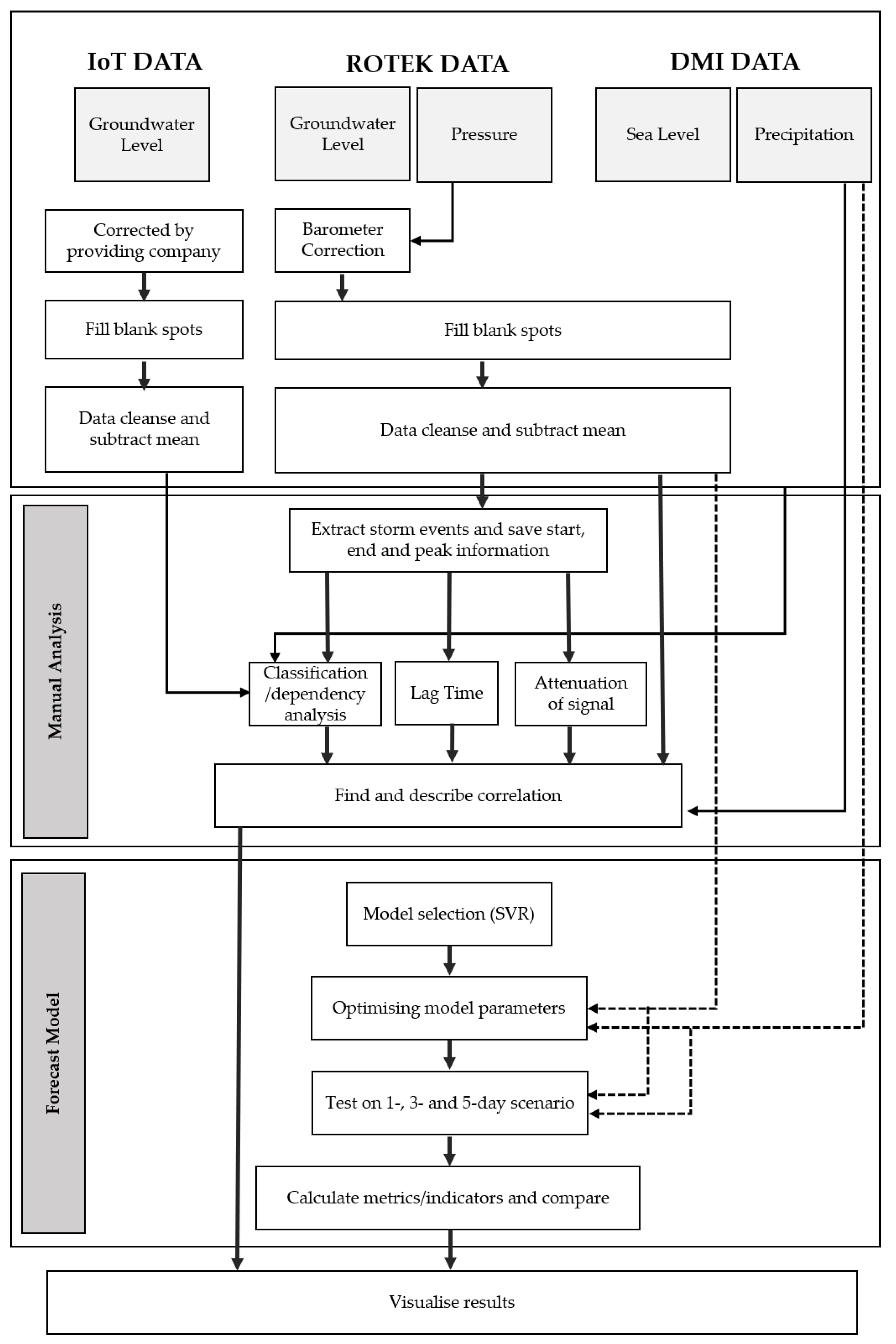


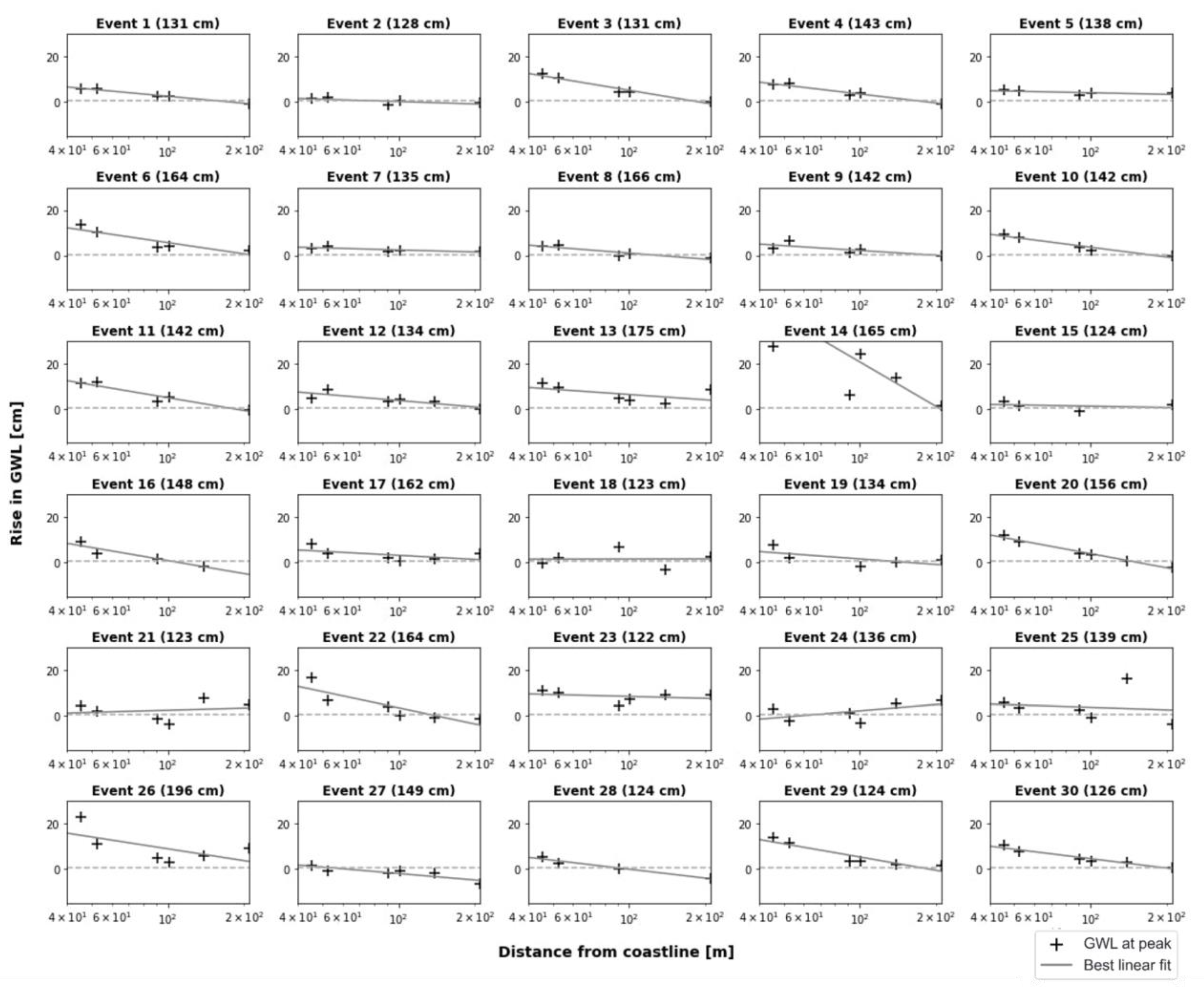
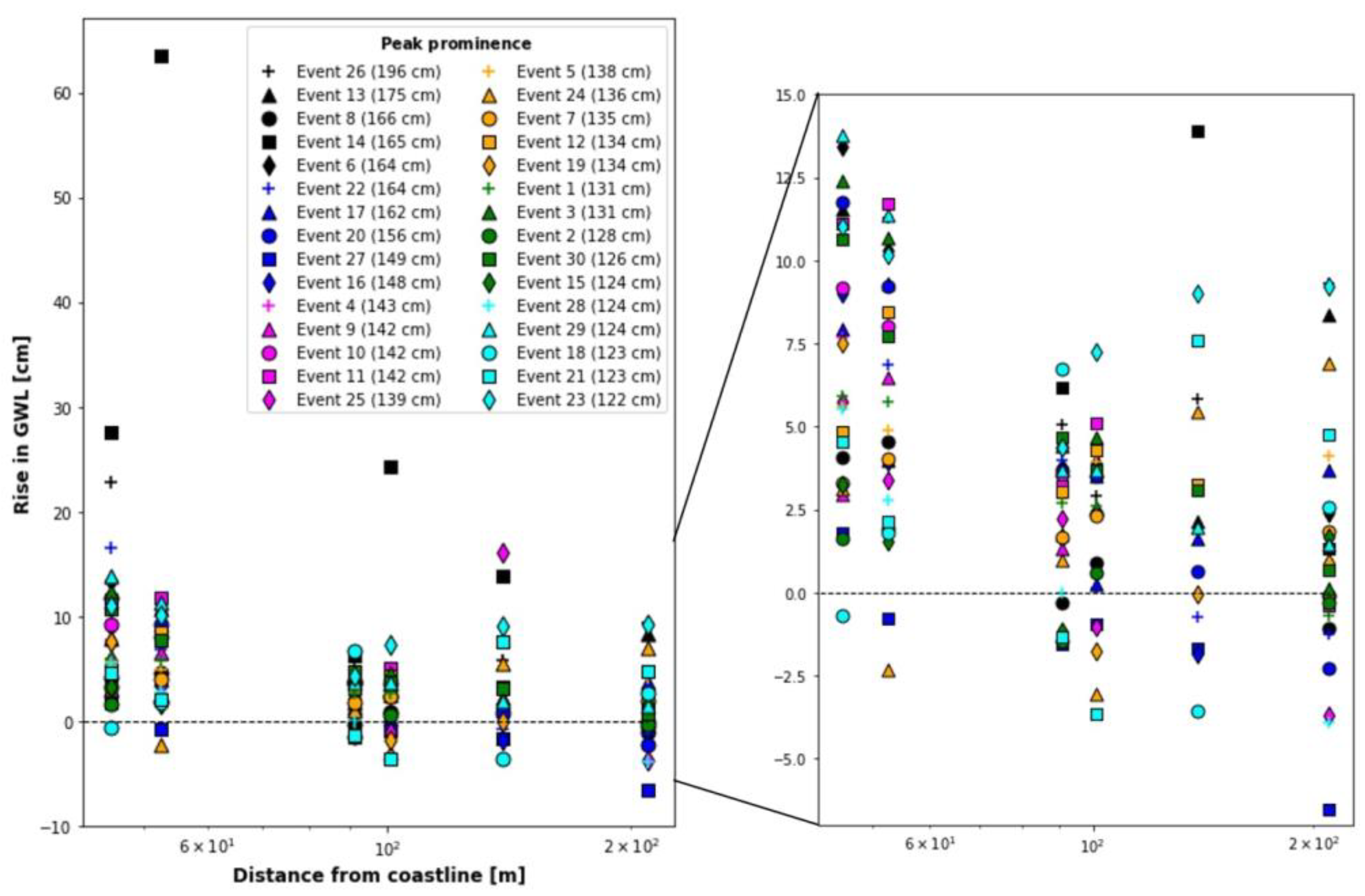
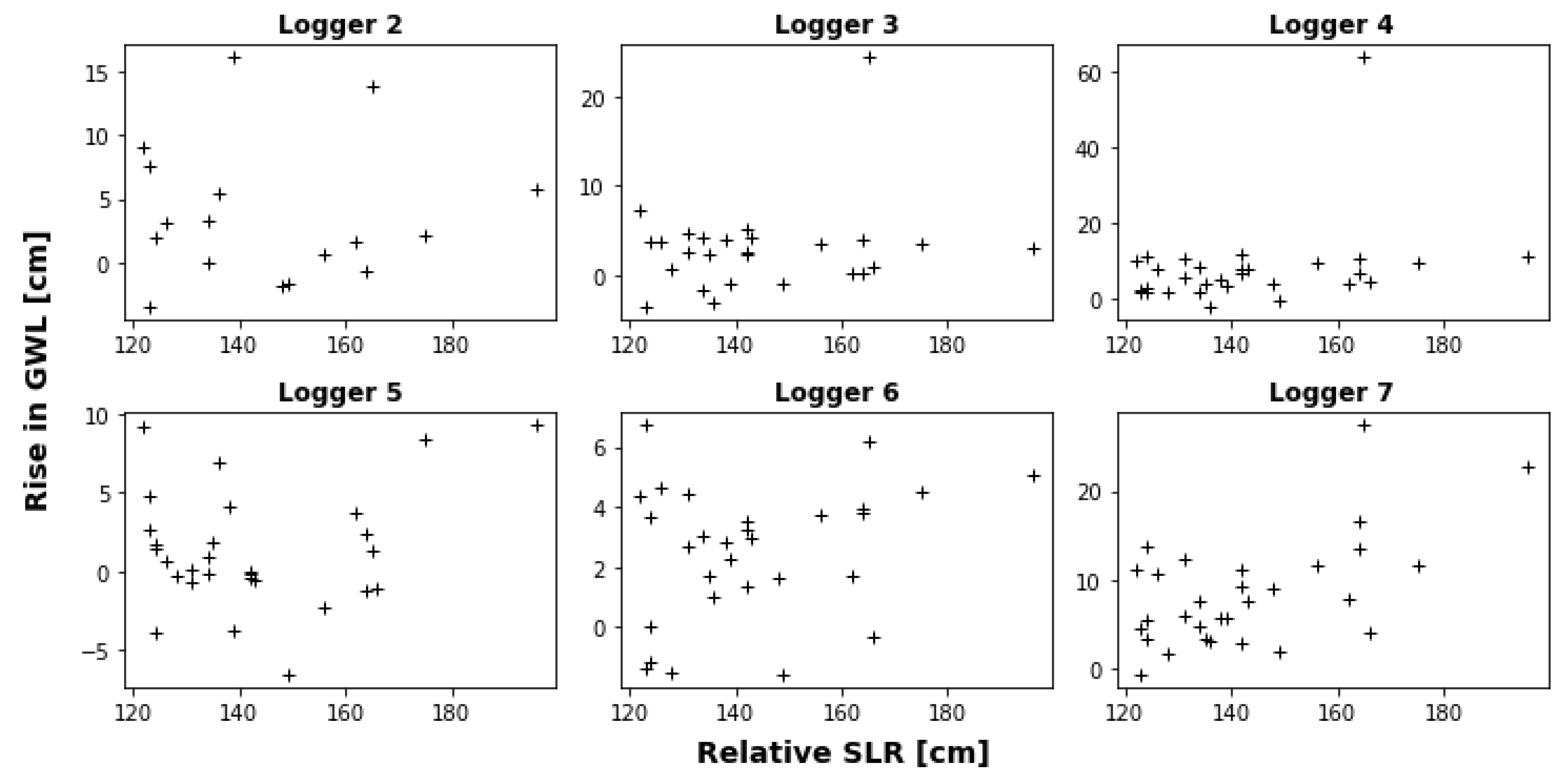

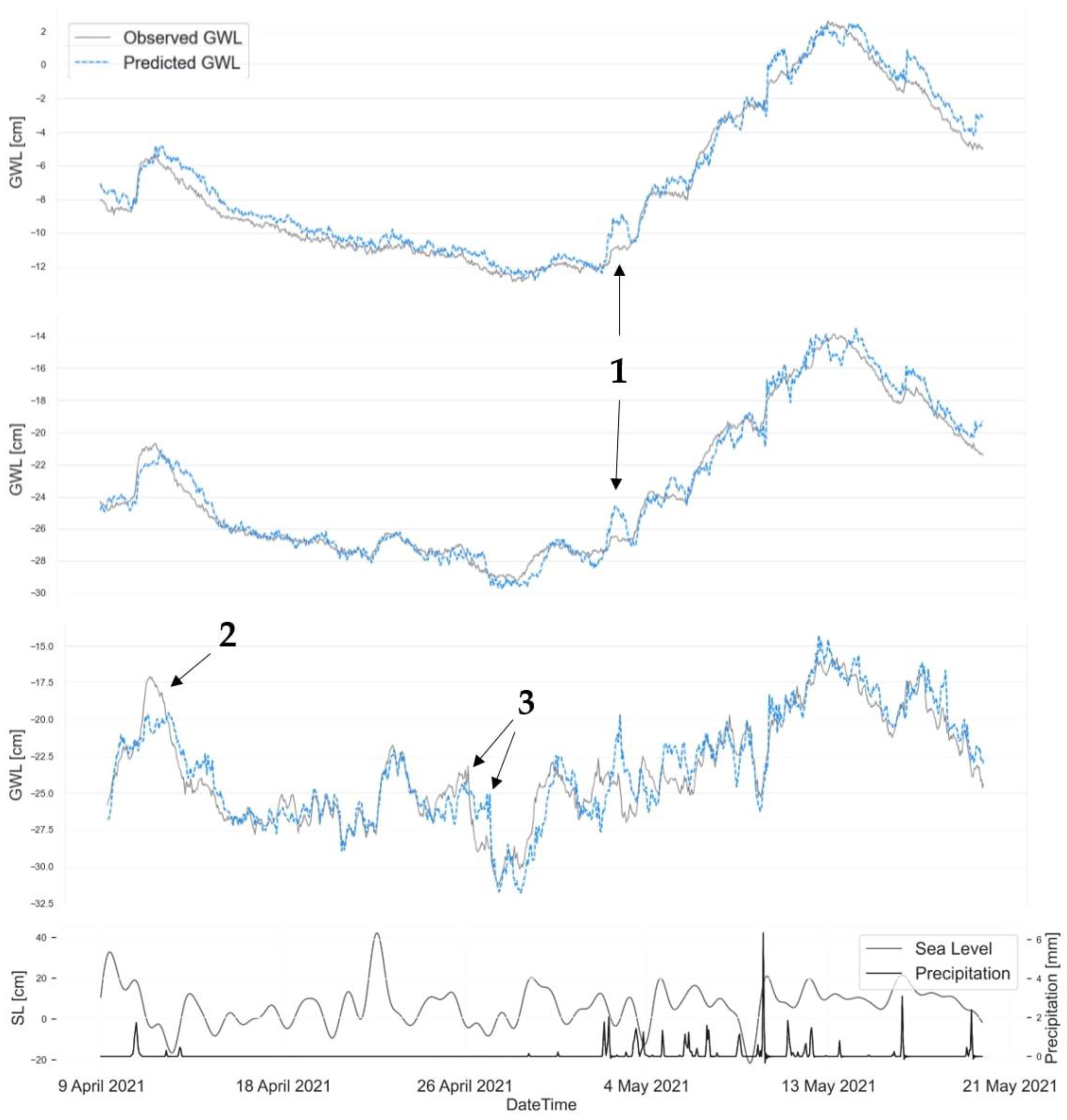


| Logger Type | Logger No. | Parameter | LON | LAT | Distance to Coast (m) | Start Time |
|---|---|---|---|---|---|---|
| Rotek loggers | 1 | Barometer | 55.719466 | 9.997424 | 139 | 27 September 2017 |
| 2 | GWL | 55.719519 | 9.997907 | 139 | 1 August 2018 | |
| 3 | GWL | 55.719519 | 9.998589 | 101 | 27 September 2017 | |
| 4 | GWL | 55.712096 | 10.01651 | 52,5 | 27 September 2017 | |
| 5 | GWL | 55.712857 | 10.018334 | 210 | 27 September 2017 | |
| 6 | GWL | 55.713039 | 10.019108 | 91 | 27 September 2017 | |
| 7 | GWL | 55.715592 | 10.016333 | 45,5 | 27 September 2017 | |
| IoT loggers | 8 | GWL | 55.700241 | 10.019238 | 25 | 9 November 2021 |
| 9 | GWL | 55.700759 | 10.019567 | 85 | 9 November 2021 | |
| 10 | GWL | 55.701656 | 10.021771 | 237 | 9 November 2021 | |
| 11 | GWL | 55.702416 | 10.023098 | 166 | 9 November 2021 | |
| 12 | GWL | 55.702576 | 10.024219 | 95 | 9 November 2021 | |
| 13 | GWL | 55.708428 | 10.019977 | 93 | 9 November 2021 | |
| 14 | GWL | 55.70956 | 10.019282 | 93 | 7 December 2021 | |
| 15 | GWL | 55.710447 | 10.018632 | 111 | 7 December 2021 | |
| 16 | GWL | 55.711681 | 10.01765 | 153 | 7 December 2021 | |
| 17 | GWL | 55.712459 | 10.018539 | 90 | 10 November 2021 | |
| 18 | GWL | 55.714725 | 10.012991 | 106 | 10 November 2021 | |
| 19 | GWL | 55.716101 | 10.008804 | 75 | 9 November 2021 | |
| 20 | GWL | 55.716932 | 9.999464 | 122 | 7 December 2021 | |
| 21 | GWL | 55.717932 | 10.001148 | 67 | 7 December 2021 | |
| DMI loggers | 100 | Sea level | 55.7156 | 10.0163 | - | 27 September 2017 |
| 101 | Precipitation | 55.7102 | 9.9962 | - | 27 September 2017 |
| Event No. | Start Datetime | Peak Datetime | End Datetime | Peak Prominence [cm] | SL at Peak (cm) (DVR90) |
|---|---|---|---|---|---|
| 1 | 7 October 2017 | 13 October 2017 | 19 October 2017 | 131 | 79 |
| 2 | 13 October 2017 | 18 October 2017 | 25 October 2017 | 128 | 76 |
| 3 | 14 November 2017 | 19 November 2017 | 26 November 2017 | 131 | 88 |
| 4 | 6 December 2017 | 11 December 2017 | 18 December 2017 | 143 | 89 |
| 5 | 30 December 2017 | 4 January 2018 | 11 January 2018 | 138 | 87 |
| 6 | 11 January 2018 | 16 January 2018 | 23 January 2018 | 164 | 91 |
| 7 | 23 January 2018 | 28 January 2018 | 4 February 2018 | 135 | 74 |
| 8 | 7 February 2018 | 12 February 2018 | 19 February 2018 | 166 | 68 |
| 9 | 11 February 2018 | 16 February 2018 | 23 February 2018 | 142 | 60 |
| 10 | 22 February 2018 | 27 February 2018 | 6 March 2018 | 142 | 60 |
| 11 | 11 March 2018 | 16 March 2018 | 23 March 2018 | 142 | 60 |
| 12 | 13 November 2018 | 18 November 2018 | 25 November 2018 | 134 | 55 |
| 13 | 29 November 2018 | 4 December 2018 | 11 December 2018 | 175 | 109 |
| 14 | 3 January 2019 | 8 January 2019 | 15 January 2019 | 165 | 136 |
| 15 | 13 January 2019 | 18 January 2019 | 25 January 2019 | 124 | 74 |
| 16 | 6 February 2019 | 11 February 2019 | 18 February 2019 | 148 | 79 |
| 17 | 3 March 2019 | 8 March 2019 | 15 March 2019 | 162 | 104 |
| 18 | 11 March 2019 | 16 March 2019 | 23 March 2019 | 123 | 71 |
| 19 | 13 March 2019 | 18 March 2019 | 25 March 2019 | 134 | 76 |
| 20 | 10 September 2019 | 15 September 2019 | 22 September 2019 | 156 | 108 |
| 21 | 23 October 2019 | 28 October 2019 | 4 November 2019 | 123 | 79 |
| 22 | 24 November 2019 | 29 November 2019 | 6 December 2019 | 164 | 111 |
| 23 | 2 December 2019 | 7 December 2019 | 14 December 2019 | 122 | 102 |
| 24 | 7 December 2019 | 12 December 2019 | 19 December 2019 | 136 | 86 |
| 25 | 30 January 2020 | 4 February 2020 | 11 February 2020 | 139 | 93 |
| 26 | 4 February 2020 | 10 February 2020 | 16 February 2020 | 196 | 136 |
| 27 | 18 February 2020 | 23 February 2020 | 1 March 2020 | 149 | 102 |
| 28 | 8 March 2020 | 14 March 2020 | 20 March 2020 | 124 | 79 |
| 29 | 24 March 2020 | 29 March 2020 | 5 April 2020 | 124 | 75 |
| 30 | 11 September 2020 | 17 September 2020 | 23 September 2020 | 126 | 78 |
| 1 Day | 3 Days | 5 Days | ||||
|---|---|---|---|---|---|---|
| Average | Std. Dev. | Average | Std. Dev. | Average | Std. Dev. | |
| R2adj | 0.76 | 0.19 | 0.43 | 0.37 | −0.27 | 0.78 |
| R2pred | 0.10 | 0.99 | 0.23 | 0.51 | −0.65 | 1.12 |
| MAE | 1.30 | 0.56 | 3.14 | 1.06 | 4.90 | 1.67 |
| RMSE | 1.99 | 1.07 | 6.94 | 2.45 | 13.02 | 4.29 |
Disclaimer/Publisher’s Note: The statements, opinions and data contained in all publications are solely those of the individual author(s) and contributor(s) and not of MDPI and/or the editor(s). MDPI and/or the editor(s) disclaim responsibility for any injury to people or property resulting from any ideas, methods, instructions or products referred to in the content. |
© 2023 by the authors. Licensee MDPI, Basel, Switzerland. This article is an open access article distributed under the terms and conditions of the Creative Commons Attribution (CC BY) license (https://creativecommons.org/licenses/by/4.0/).
Share and Cite
Forchhammer Mathiasen, R.; Padkær Haugan, E.; Raaschou Andersen, T.; Højmark Hansen, H.; Bondo Medhus, A.; Erbs Poulsen, S. Short-Term Ocean Rise Effects on Shallow Groundwater in Coastal Areas: A Case Study in Juelsminde, Denmark. Water 2023, 15, 2425. https://doi.org/10.3390/w15132425
Forchhammer Mathiasen R, Padkær Haugan E, Raaschou Andersen T, Højmark Hansen H, Bondo Medhus A, Erbs Poulsen S. Short-Term Ocean Rise Effects on Shallow Groundwater in Coastal Areas: A Case Study in Juelsminde, Denmark. Water. 2023; 15(13):2425. https://doi.org/10.3390/w15132425
Chicago/Turabian StyleForchhammer Mathiasen, Ronja, Emilie Padkær Haugan, Theis Raaschou Andersen, Henriette Højmark Hansen, Anna Bondo Medhus, and Søren Erbs Poulsen. 2023. "Short-Term Ocean Rise Effects on Shallow Groundwater in Coastal Areas: A Case Study in Juelsminde, Denmark" Water 15, no. 13: 2425. https://doi.org/10.3390/w15132425






